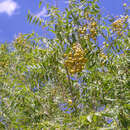en
names in breadcrumbs


Sapindus saponaria is a small to medium-sized deciduous tree[3] native to the Americas. Common names include wingleaf soapberry,[4] western soapberry, jaboncillo,[2] sulluku[5][6][7] and manele and a'e (Hawaiian).[8] Its genus name, "Sapindus", comes from the Latin, meaning Indian soap, and its specific epithet means "soapy."[3]
Two subspecies are recognized:
This species has a very wide native range throughout the Americas, ranging from Kansas (with isolated populations known as far north as Montana, Colorado, and Missouri) east to Florida and the West Indies, and south to Paraguay. Populations are also known from isolated oceanic islands, including Clarion Island, the Galápagos Islands, and the Hawaiian Islands.[1]
It often grows in clumps or thickets reaching about 20 ft. (6.1 m) in height in the western part of its range. Solitary trees though can grow as tall as 50 ft. (15.2 m) in height. In the western part of its range it is most often found growing at the head of prairie ravines, the margins of woodlands, the edges of fields or on rocky hillsides.
The leaves of the soapberry are alternate, pinnately compound, thick and leathery but deciduous, 8 in. (20 cm) to 15 in. (38 cm) in length, made up of 6 to 20 narrow lanceolate leaflets with smooth margins, long tapered tips, and uneven wedge-shaped bases which are 2 in. to 5 in. (5 cm to 13 cm) long and .75 in. to 1.5 in. (2 cm to cm) wide. Midveins on leaves of var. saponaria are mostly winged, while those of var. drummondii are never winged.
The inflorescence are dense terminal panicles of small white flowers 6 in. to 10 in (15 cm to 20 cm) long. Flowering occurs in May–June for var. drummondii and in November for var. saponaria.
The fruit occur in large pyramidal clusters at the ends of branches. Each golden colored fruit is between 1.2 in. to 1.4 in. (3 cm to 3.6 cm) in diameter and becomes translucent and wrinkled when fully mature and contains a single black seed about .35 in (9 mm) in diameter. Fruits of var. drummondii ripen in October and often remain on the tree until spring, while those of var. saponaria ripen in spring. The fruits can contain as much as 37% of saponin, and when macerated in water they produce a soapy lather.[12] Formerly, they were much used in Mexico and in other regions for laundering clothes.[12]
The twigs of var. drummondii are gray-brown and hairy with short tan colored hairs while those of var. saponaria are gray and hairless. Buds on var. drummondii are small dark brown and hairy while those on var. saponaria are small brown and hairless.
The trunk of var. drummondii has light gray, scaly with thin plate like bark and sometimes shallowly furrowed while var. saponaria has gray to reddish colored scaly bark.
The dark round seeds are made into buttons and necklaces. The wood splits easily and is made into baskets.[13]
The fruit of S. drummondii are poisonous and can cause skin rashes;[13] they have been used to stupefy fish.[14] The foliage may also be toxic to livestock.[13]
Sapindus saponaria is a small to medium-sized deciduous tree native to the Americas. Common names include wingleaf soapberry, western soapberry, jaboncillo, sulluku and manele and a'e (Hawaiian). Its genus name, "Sapindus", comes from the Latin, meaning Indian soap, and its specific epithet means "soapy."